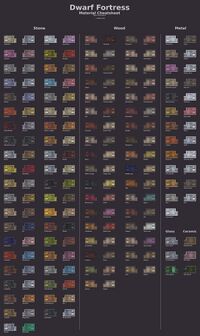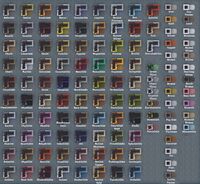- v50 information can now be added to pages in the main namespace. v0.47 information can still be found in the DF2014 namespace. See here for more details on the new versioning policy.
- Use this page to report any issues related to the migration.
Material
v53.06 · v0.47.05 This article is about the current version of DF.Note that some content may still need to be updated. |
- For information on the physical properties of materials, see Material science.
Materials are the wide array of base resources from which objects can be created. Different materials have different base properties (including value multipliers which can significantly affect the value of the item - a gold throne is worth more than an identical-quality lead one, for example).
Not every end-product can be made of all materials, and similar materials may have very different properties - for instance, obsidian is the only stone that can be used to make stone-based weapons, only magma-safe stones will not melt when immersed in magma, and fire imp leather will not burn. While nearly all metals can be made into furniture and crafts, only a select few can normally be made into weapons and armor. These metals are generally called weapon-grade metals. This alone doesn't necessarily give these materials a higher base value, but it may make them worth more to the player and their fortress in a practical sense.
Some dwarves have preferences for one material over another - they receive a happy thought when working with the material, tend to produce higher-quality results, and perceive items (or rooms) made of the material as higher-quality, which can also give them more happy thoughts, e.g:
Unib Rulushlikot likes rhyolite, silver, amber opal, persimmon wood and giant emu leather.
General groups of materials include, but are not limited to:
Certain materials tend to be geared toward making certain items - while stone, wood, metal, and glass can be made into similar furniture, there are some items which are normally restricted to certain materials. For example, beds can only be made out of wood, and bins and buckets cannot be made out of stone. Cloth and leather can both be made into clothing, but leather can also be used to make armor. Gems are largely for encrusting finished items made from other materials. Of over two dozen different metals and alloys, only a handful are usable to make weapons.
In all cases, each group of materials is divided into many possible sub-types of material; there are, for instance, 11 pure metals, another 14 alloys, scores of different types of stone and well over 100 different types of gems. It is best to look up each individual category, or particular material, to become familiar with its value and what it can and cannot be used for.
See Also:
| More: Gems • Metals • Stones | |
| Creature | |
| Plant | |
| Creature/Plant |
Alcohol • Cloth/Thread • Extract (Golden salve • Gnomeblight • Honey • Royal jelly • Syrup • Venom) • Glob • Liquids • Soap |
| Inorganic |
Metal • Milk of lime • Soil (Clay • Sand) • Stone (Ash glaze • Earthenware • Gem • Gypsum plaster • Porcelain • Quicklime • Stoneware • Tin glaze) |
| Hardcoded | |
| Glitch | |
| See also: Material science | |



